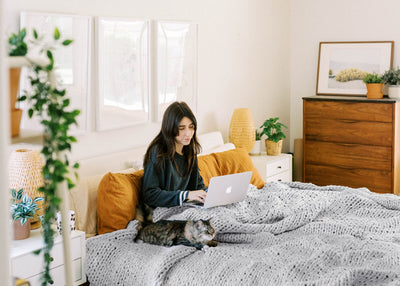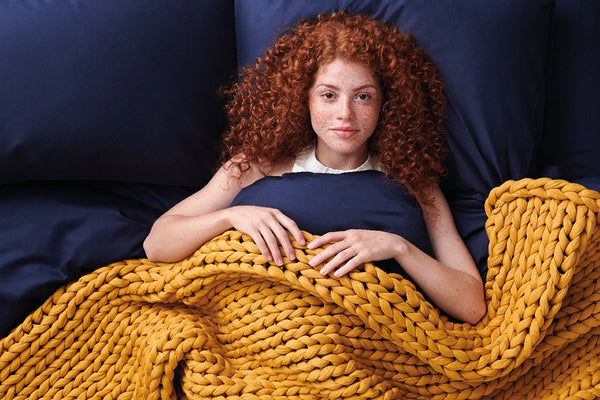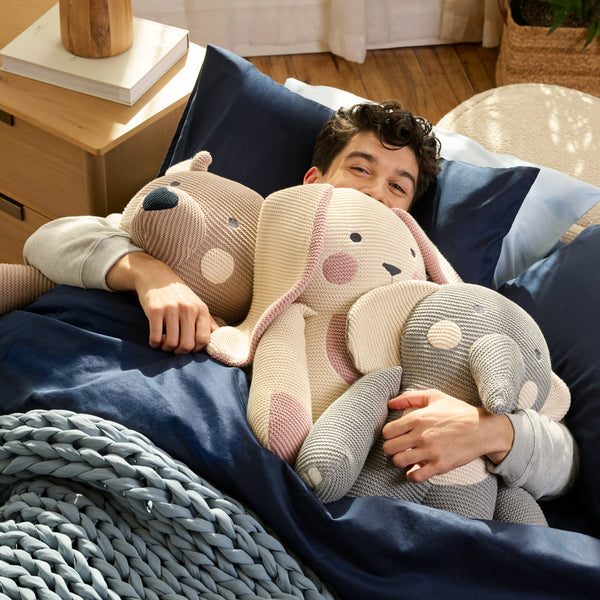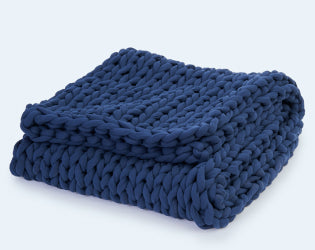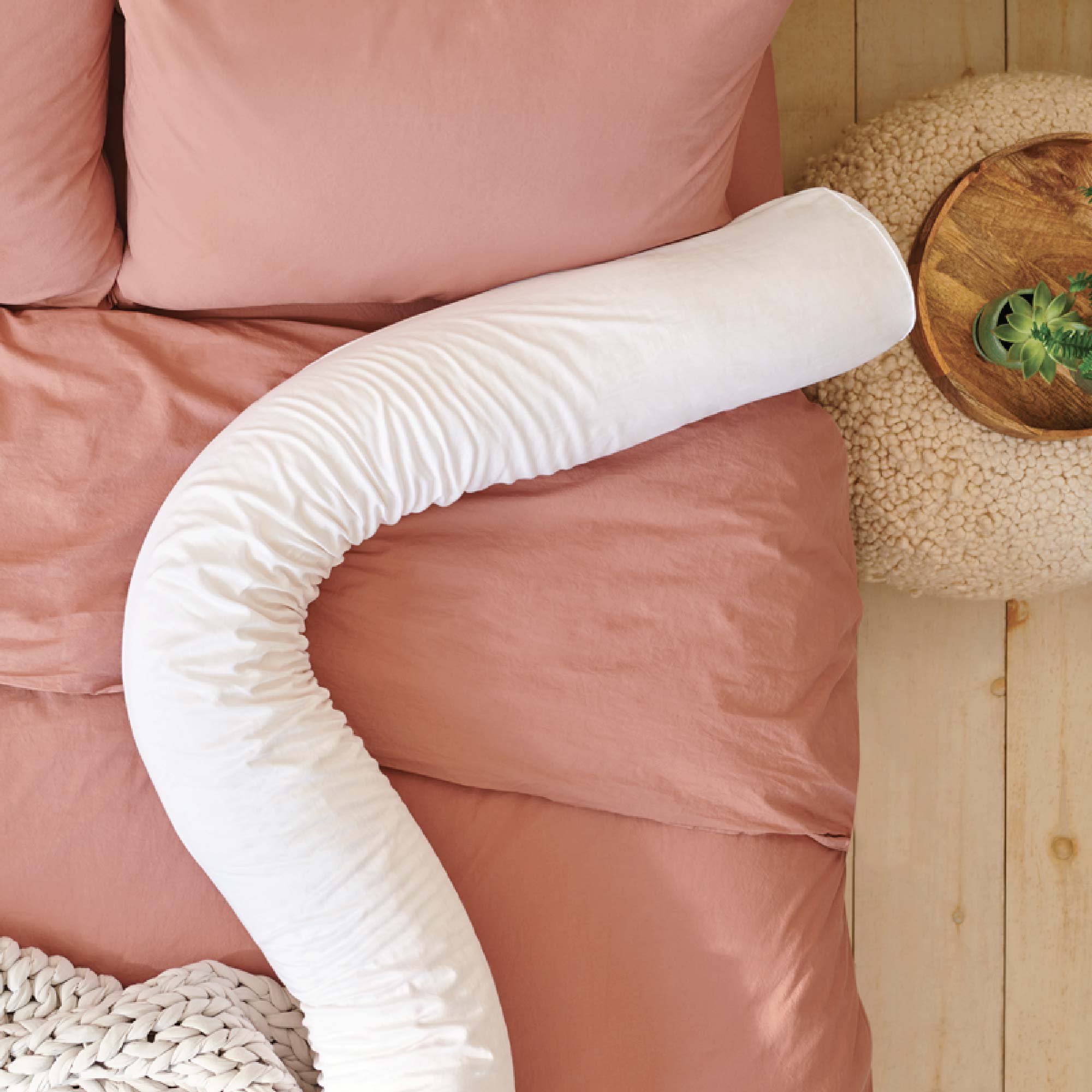Why Does My Dog Sleep On Their Back? Common Canine Sleep Positions Explained
Why do dogs sleep on their backs? This sleeping position helps pups stay cool and comfortable. In fact, if your dog is sleeping on their back, it could be a sign that they’re relaxed and feeling at home!

Bearassentials
Dogs don’t sweat as much as people, and most of their sweat glands are located in their paws
Back sleeping is a sign that a dog or cat feels safe and at home
Changes in a dog’s sleep patterns might be a sign of underlying health conditions
Did you know?
Long after puppyhood, many dogs continue to sleep best when snuggled up next to somebody.
Depending on factors like weather, mood, and health, dogs choose to sleep in different positions throughout the year. On a cold night, they might want to snuggle up in a plush dog bed, while hot afternoons might lead them to stretch out directly on the floor.
Understanding a little bit more about your dog’s needs can help you see why they might be choosing to sleep on their back.
Common Dog Sleeping Positions
Since dogs tend to sleep in short bursts throughout the day and night, it’s common to catch your pup snoozing in different positions throughout the house. As adorable as it is when your dog curls up to sweet dreams of chasing rabbits, sometimes these sleep positions can be a little alarming!
Why does my dog lay on his back? Or what does it mean when my dog lays on her back with paws up?
This is a natural sleep position that helps dogs cool down. Many other factors might make your dog more likely to sleep this way, such as arthritis or injuries.
There are different variations of this sleeping position that might bring up similar questions, so we’ve rounded up a few of them here to help interpret just what they mean for your pup.
As a general rule of thumb, if your dog isn’t exhibiting any unusual changes in their sleep patterns, there’s probably nothing to be concerned about when it comes to sleeping positions.
That said, changes in your dog’s sleep can also be an indication of underlying health conditions: for example, if your dog suddenly starts sleeping a lot less or a lot more, it can be a sign of canine depression.
A sudden change in sleeping position could also indicate an injury, such as if your pup starts avoiding putting weight on one of their legs.

Why does my dog sleep on his back with their legs in the air?
Dogs usually sleep on their backs because they’re too hot! Back sleeping helps dogs cool down, since the fur on their bellies is thinner and lets more air flow. Back sleeping also helps dogs to sweat more effectively. This is because dogs sweat mainly through the pads of their paws.
This particular dog sleeping position might be the most alarming, especially if your dog likes to keep their paws straight up in the air. But it’s most likely just a sign that your pup is a bit too warm.
Of course, overheating can also have health implications, so you’ll want to make sure you’re doing all you can to create a cool and comfortable sleep environment. Remember, dogs have a harder time regulating their body temperature than we do!
Dogs with long hair or insulating fur may find hot, humid weather particularly difficult. It’s best to limit their time outside and make sure they have access to plenty of cold and shady spots to rest. A cooling, breathable dog bed like our Pupper Pod could also be a helpful addition to your dog’s space.
Why does my dog lay with their back legs out?
Dogs with flatter faces like pugs or bulldogs often sleep with their back legs out to help with temperature regulation. For these dogs, sleeping entirely on their backs might be uncomfortable, since it could restrict their airflow
In general, dogs won’t choose to sleep in a position that makes it difficult to breathe. This sleeping position cools down the dog’s back paws while keeping the airways elevated.
Why does my dog sleep stretched out on their back?
Back sleeping is a sign that your dog is comfortable in their surroundings, so this sleeping position usually means that your four-legged friend is completely at ease. They feel safe enough to stretch out with their soft belly facing the world.
For some dogs, back sleeping is an easier option than front sleeping because it takes pressure off the joints. Stretching out on their back gives the dog’s paws a much-needed break. This might be especially true for older dogs or dogs recovering from a recent injury.
Just like every person prefers a different sleeping position, dogs typically choose to sleep in the position that’s most comfortable for them. It might seem like your dog is stretching out in an uncomfortable way, but when your dog is sleeping on their back, they’re likely in a fully relaxed state.
What feels relaxed for your dog might not look the most comfortable to you, and that’s okay!

Why does my dog like to sleep beside me and roll over on his back?
Some dogs need the security of knowing that their people are close by before they can fully relax onto their backs. In other words, having you next to them helps your dog feel safe enough to sleep in this position.
Your dog might even prefer to cuddle up next to you in order to fall asleep more easily. Puppies start out their lives sleeping snuggled up against their mothers and littermates, so some dogs continue to enjoy the comfort of a snuggle up through adulthood.
Why does my cat sleep on their back?
Cats sleep on their backs when they feel safe and confident. Like dogs, cats are only likely to sleep on their backs if they feel a sense of trust for the people around them.
However, while a dog might welcome a belly rub or scratch while in this position, it’s important to be more careful with cats! If you touch a sleeping cat’s tummy, you might just end up getting scratched.
Dog Sleep Health
So ultimately, is it healthy for dogs to sleep on their back? The answer is yes, so long as your dog is otherwise healthy and isn’t prone to overheating. Most dogs who sleep on their backs are just trying to cool down!
If you’re wondering what your dog’s sleep habits can tell you about their health, it’s worth paying attention to how much they sleep, not just the position they sleep in.
Once you start keeping an eye on this, you’ll notice some patterns. What does it mean when your dog sleeps back to back hours? Or if your dog suddenly starts to sleep for much shorter periods of time?
Any changes in your dog’s sleep pattern could be a cause for concern. Sleep pattern changes are sometimes symptoms of more serious conditions like heart disease or diabetes, so you should talk to your vet if these questions begin to come up.
Conclusion
Back sleeping is common for dogs who are too hot and trying to cool down. If your dog is comfortable sleeping on their back, it’s a sign that they trust you and feel at home in their environment.
Dogs with flat noses might find it difficult to sleep on their backs, and they’ll likely prefer to sleep with their back paws extended behind them to cool down.
If you’re concerned about your dog’s sleeping position, it’s never a bad idea to ask your vet for advice. You can also take cues from your dog to create a more comfortable sleep space for them, investing in dog beds for different weather or creating a shaded corner for canine slumber.
Getting to know your dog’s particular sleep patterns will help you to understand if they may be experiencing a health change. Our four-legged friends need restorative rest just like we do, and understanding more about their sleep needs is a big step for any pet parent!





